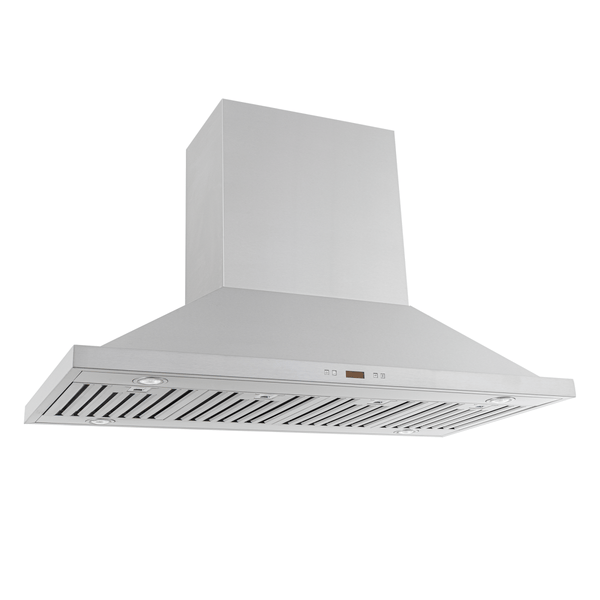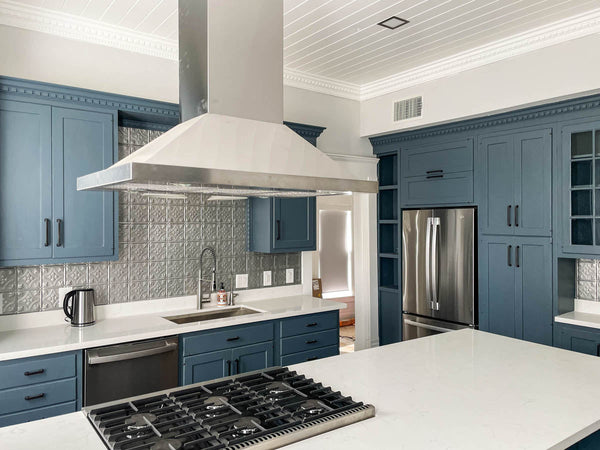Table of Contents
Which roof cap should I use for my vent hood?
A roof cap is an important part of a ducted range hood installation. If you are venting your hood through the roof, consider purchasing a roof cap to keep your duct in good condition.
In general, the roof cap should match the diameter of your ductwork. Here are the ductwork sizing requirements:
For vent hoods up to 600 CFM, use a 4” roof cap. For vent hoods between 600 and 900 CFM, use a 6” cap. For hoods between 900 and 1200 CFM, an 8” cap is ideal. Finally, use a 10” or larger roof vent cap for hoods over 1200 CFM.
Learn more about Best options for a roof cap and why the right one matters.
Who are we? For more than 20 years we have specialized in and sold thousands of range hoods to suit any kitchen or cooking style. Explore our hood types, including under-cabinet, wall-mount, island, outdoor, and insert range hoods.
What is a roof vent cap?
A roof vent cap or roof cap is a stainless steel accessory that keeps large debris and small animals from entering your ductwork. It is used to cap vertically run ducting, in contrast to a wall cap, which seals ducting (calculate ducting here) that vents out an exterior wall.
A roof vent cap does all this while allowing your kitchen air to move smoothly and efficiently outside your home.
Without a roof cap, large debris may hinder your range hood from moving air efficiently out of your home. When a hood can’t easily move air it causes grease and dirt to buildup inside your ductwork. Cleaning your ductwork can be costly, but it is entirely preventable with a roof cap along with consistent cleaning of your baffle or mesh filters.
What is the best roof vent cap?
Proline Vexair Roof Caps (6″ – 12″) – Our Top Pick for Quality.
Proline’s Vexair series of roof caps are constructed from high-quality metal and come in two size ranges: one model fits 6″–8″ ducts and a larger model fits 10″–12″ ducts (perfect for high CFM hoods).
Builder’s Best Roof Vent Cap
The best roof vent cap is the Builder’s Best Roof Vent Cap. It is available in both 4” and 6” diameter, which makes it a great fit for range hoods up to 900 CFM. This roof cap is manufactured with a durable galvanized steel. It’s a reliable option for your range hood.
Buy your Builder’s Best roof cap at this link from Amazon.
Plastic Oddities Roof Vent Cap
The Plastic Oddities Roof Vent Cap will fit comfortably on your 4” pipe. It’s a great fit for your ducted 600 CFM range hood. This roof cap features a unique circular design. It will keep leaves, dirt, and small animals from entering your vent so that your range hood can run at peak efficiency.
Purchase the Plastic Oddities Roof Vent Cap from Amazon here.
Lomanco Whirlybird Ventilator
The Lomanco roof cap is a high quality, durable 12” roof vent cap. This is a large vent cap that can efficiently vent your 1200+ CFM range hood. This roof cap comes in brown, stainless steel, and black finishes.
Purchase your Lomanco roof cap on Amazon here.
Broan Roof Vent Kit
The Broan Roof Vent Kit has everything you need to install your roof vent. It is easy to install, affordable, and durable. The kit comes with a backdraft damper to prevent air from moving back inside the kitchen. It also features a screen to block large debris and small animals from coming inside the duct.
How do you vent a range hood on a roof?
To vent a range hood on a roof, run ductwork through your attic and cut a hole in your ceiling. The most important thing is to cut a hole that is large enough for your ductwork. Luckily, you can cut a smaller hole first and line it up with the ductwork to cut the appropriate size after the fact. Then, attach the roof cap to your ductwork.
Consult a professional to install your ductwork and roof vent cap.
If you’d like to learn more about the installation process, check out this article for a step by step breakdown on how to install your range hood through the ceiling.
What happens if a roof is not vented?
If a roof is not vented, then grease, dirt, smoke, and chemicals will build up inside your attic. It can be dangerous to your health to keep these contaminants inside your home. Venting your range hood into the attic essentially defeats the purpose of having a ducted range hood. Not to mention that over time, the grease buildup may damage your attic.
If you’re venting your range hood out of an exterior wall, you don’t need to worry about venting your roof. You only need to be concerned about venting your roof if you install vertical ductwork through the ceiling for your range hood.
View our comprehensive collection of range hoods and find your next hood.
We hope that this brief introduction to roof caps for your range hood has been helpful. If you have any questions about sizing your roof cap, feel free to call us at (877) - 901 - 5530.












